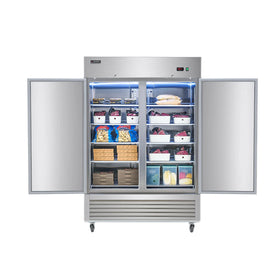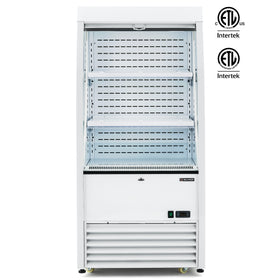If you’re in the food, beverage, or retail business, choosing the right commercial refrigerator is a crucial decision. In many ways, a refrigerator does more than just store and display your goods- it’s a pillar that supports a sales strategy.
This explains why two of the most common refrigerator choices for businesses in the food business are open-air merchandisers and glass-door refrigerators. Both are designed to keep products cold and visible, and in many cases, either one will suffice.
However, if you are looking to maximise your sales, understanding the subtle differences in how each of these refrigerators influences customer behaviour, operating costs, and brand perception is crucial.
So, which one is better for your business? Let’s break it down.

1. Sales Impact: Volume vs. Margin
i. Open-Air Merchandiser
An open-air refrigerator mainly drives higher sales volume by encouraging and stimulating impulse purchases.
In fact, open-air merchandisers are “open-air” for a reason: they are specifically designed to make it as easy as possible for customers to reach in and grab the products. With no doors, it makes it easy for customers to see the products instantly and therefore can grab them without hesitation.
An open-air merchandiser is perfect for items that are:
- Meant to be consumed quickly: bottled drinks, snacks, or grab-and-go meals.
- They are likely to be in high demand because of the time of year, location of the business, or general environment. Think cold drinks in the summer, soft drinks around a school district, etc.
- Not very costly, and hence, are more likely to be the subjects of an impulse buy.
So, here’s the deal with open-air merchandisers: they are designed for food businesses that are focused on quick turnover, and they work best if your business is located in a high-traffic area.
They also offer you an opportunity to make the most of changes in seasons and other temporal changes during the year to rotate products and maximise sales.
ii. Glass-Door Refrigerators
Glass door refrigerators support higher margins mainly by creating a premium feel. A glass-door refrigerator is typically designed such that a customer is encouraged to purchase more deliberately and is more likely to go for higher-value products.
When you use a glass door refrigerator, you attract the customer’s attention to the product: its quality, its colour, and its appeal. Think of craft beer, specialty foods, or dairy items.
Glass door refrigerators work well for items that may not be at the lower end of the price range, but have an appeal to them. Consider a glass door refrigerator if you deal in the following kinds of products, like cakes, wines, beers, pizzas, big brand-name foods, etc.
Rule of Thumb
- If your goal is to sell more items quickly, open-air wins.
- If your goal is to sell fewer, higher-margin items, a glass door takes the edge.

2. Operating Costs and Energy Use
i. Open-Air Merchandiser: Energy Efficiency and Operating Cost
Compared to a glass-door refrigerator, an open-air refrigerator is less efficient and more costly to run. With an open-air refrigerator, cold air spills out constantly, which means higher electricity bills and stronger compressors that work harder.
Your products may also spoil faster, which is why it is advisable to only go for an open-air merchandiser if your products are likely to sell quickly.
That being said, the increased energy consumption of open-air merchandisers should not be a turn-off. Advanced models come with features and components to help boost energy efficiency. It all depends on the model and the manufacturer you choose.
Consider Wilprep’s open-air merchandisers:
- Each unit comes with a pull-down night curtain for energy conservation when not in use
- Digital controls for accurate and adjustable temperature control
- The back panels are perforated to boost airflow and ensure the items are evenly chilled
- Certified by ETL and ETL sanitation for reliable performance.
If your open-air merchandiser shares these features, you can conserve a significant amount of energy costs, enjoy smooth operation, and choose what is best for your business without any worries.
ii. Glass-Door Refrigerator: Energy Efficiency and Operating Cost
All things being equal, glass-door refrigerators are more energy efficient and thus less costly to run than open-air merchandisers. The glass door ensures a closed environment that keeps cold air inside, extending product shelf life and lowering energy consumption.
Consider this 44.1" 2 Door Glass Commercial Display Refrigerator. With a total storage capacity of 19.8 cu.ft and four adjustable shelves, it can display up to 555 standard 12 oz. However, it consumes only 3.5 kWh/24h.
Here’s why:
- The thermal insulation is excellent. It is built with a high-density insulation layer and low-E tempered glass doors.
- It has a high-performing cooling system. The Embraco compressor with R290 refrigerant provides high efficiency and energy savings for long-term reliability
Rules for Choosing
On average, a glass-door refrigerator should consume less energy than an open-air model, and that should factor into your considerations. However, with a trusted brand, you can find an energy-efficient open-air refrigerator that cuts energy consumption and boosts your sales.
If you are going for a glass-door refrigerator, understand that some are more energy efficient than others, and features like thermal insulation and the quality of the cooling system should take priority.
Side-by-Side Comparison
| Factor | Open-Air Merchandiser | Glass-Door Refrigerator |
| Sales Impact | Higher volume sales (impulse buys). | Higher margin sales (premium products). |
| Operating Cost | Higher (energy + spoilage). | Lower (better efficiency, longer shelf life). |
| Energy Use | High-cold air spills out. | Low to moderate -sealed environment. |
| Customer Psychology | Casual, abundant, inviting; encourages quick grabs. | Premium, clean, protective; builds trust. |
| Best For | Fast-turnover items (drinks, snacks, meals). | Premium or perishable products (beer, dairy, specialty). |
Which One Should You Choose?
Choose an Open-Air Merchandiser if:
- You’re in a high-traffic environment like a café, convenience store, or grab-and-go shop.
- Your products have a fast turnover (daily restocking is the norm).
- You want to maximise impulse purchases and encourage quick decisions.
Choose a Glass-Door Refrigerator if:
- You sell premium or specialty items where freshness perception matters.
- Your business depends on efficiency and reducing waste.
- You want a polished, upscale brand image.

Recommended Open Air Merchandisers
For a Small to Medium Business
Consider Wilprep’s Black 3 Sided Glass Display Refrigerator. It has a total capacity of 14.8 cu. ft., and features four height-adjustable shelves, each with a 66 lb capacity, to accommodate a variety of products including bottled drinks, dairy and deli items, desserts, and fresh produce.
With a quality compressor and finned copper condenser coils that keep temperatures steadily between 30-50°F with minimal energy costs, this is a compact, energy-efficient, and avoids wasted space while still displaying essentials for impulse grabs.
For smaller (and more affordable models), you can go for the 27" Vertical Open Air Merchandiser (6.7 cu. ft.) or the 24" Vertical Air Curtain Merchandiser (8 cu. Ft).
For Medium to Large Business
Consider the Wilpreps 51" Black Vertical Air Curtain Merchandiser. It has a 19.4 cu. ft. capacity and features four height-adjustable shelves, each with a 66 lb capacity, to accommodate a variety of products including bottled drinks, dairy and deli items, desserts, and fresh produce.
Perfect for balancing stock variety (drinks, salads, wraps) with manageable restocking and ideal for most medium-sized cafés.
Recommended Glass-Door Refrigerators
For a Small Business
21.2" Wilprep Commercial Merchandiser Glass-Front Refrigerator
This 21.2" Commercial merchandiser refrigerator fits well into smaller spaces while still offering ample storage space. It has a total capacity of 8.6 cu. Ft, about 240 cans.
The glass door is low-E tempered and fog-resistant. It also has a high-density insulation layer, which makes it effective for both storage and display of items.
It is ETL listed and compliant with U.L standards. Low power consumption, only 1.7 kWh/24h.
For a Medium-Sized Business
The Commercial Display Glass Front Refrigerator is a larger capacity of 19 cubic ft. and is ideal if your store is busy and/or needs to display a large inventory of cold beverages, snacks, or ready-to-eat meals. You can store up to about 510 cans, and it ensures a consistent temperature range of 32°F to 50°F. Also ETL Certified, U.L Standard Compliant

Final Takeaway
Both open-air merchandisers and glass-door refrigerators can boost sales, but in different ways. Open-air units excel in convenience and volume, while glass-door units excel in efficiency and premium perception.
Think about your business model, product mix, and customer behaviour:
- If speed and impulse are your priority, go open-air.
- If quality, longevity, and brand image matter most, go glass-door.
The right choice isn’t just about keeping products cold-it’s about shaping how customers see, feel, and buy your products.
Consider what size open-air refrigerator you need for a cafe or convenience store.










